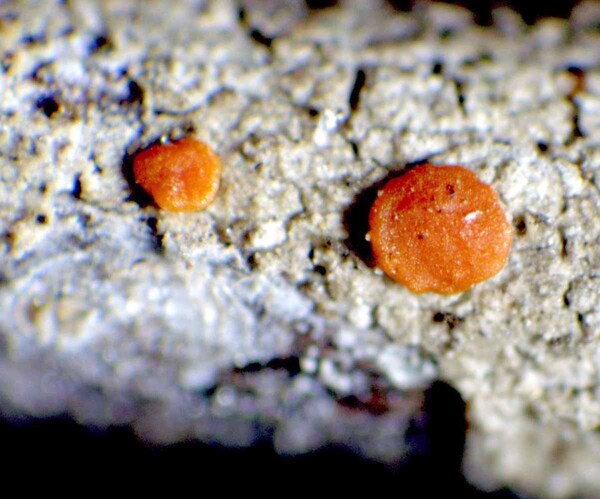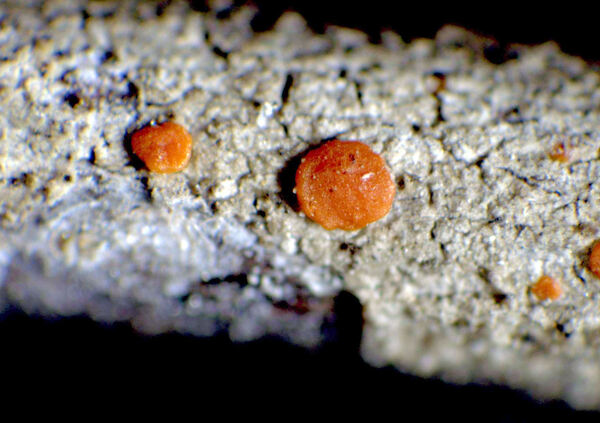Ramboldia lusitanica (Räsänen) Kalb, Lumbsch & Elix
Nova Hedwigia, 86: 34, 2008. Basionym: Protoblastenia lusitanica Räsänen - Arch. Soc. Zool.-Bot. Fenn. Vanamo, 3: 81, 1949.
Synonyms: Pyrrhospora lusitanica (Räsänen) Hafellner
Distribution: C - Tosc (TSB 35275), Sar.
Description: Thallus crustose, episubstratic, whitish or pale whitish grey, dull, continuous to weakly rimose, forming small patches. Apothecia lecideine/biatorine, bright red to orange-red, 0.4-0.8(-1) mm across, soon convex and immarginate. Proper exciple thin, prosoplectenchymatous, of radiating hyphae, orange in outer part, colourless within, the pigmented parts K+ purple-red, granular-inspersed; epithecium orange-red, with an epipsamma of fine golden yellow granules reacting K+ purple-red; hymenium colourless; paraphyses coherent, simple or sparingly branched in upper part, not much swollen at tips; hypothecium thick, colourless or pale orange. Asci 8-spored, clavate, with an amyloid tholus and broadly diverging axial mass, approaching the Lecanora-type. Ascospores 1-celled, hyaline, ellipsoid-oblong, 9-12 x 2.5-3 µm. Pycnidia red. Conidia thread-like. Photobiont: chlorococcoid. Spot tests: thallus K-, C-, KC-, P-, UV-; apothecia K+ purple-red. Chemistry: thallus with lichesterinic acid (major), and protolichesterinic acid (minor); apothecia with russulone. Note: a Mediterranean-Atlantic species found on Pinus, Cistus and Erica in humid, mostly coastal maquis vegetation, restricted to Tyrrhenian Italy. It is included as “Critically Endangered” in the Italian red list of epiphytic lichens (Nascimbene & al. 2013c).
Growth form: Crustose
Substrata: bark
Photobiont: green algae other than Trentepohlia
Reproductive strategy: mainly sexual
Restricted to humid-warm, oceanic areas
Commonnes-rarity: (info)
Alpine belt: absent
Subalpine belt: absent
Oromediterranean belt: absent
Montane belt: absent
Submediterranean belt: absent
Padanian area: absent
Humid submediterranean belt: absent
Humid mediterranean belt: extremely rare
Dry mediterranean belt: absent

Predictive model
Herbarium samples
Growth form: Crustose
Substrata: bark
Photobiont: green algae other than Trentepohlia
Reproductive strategy: mainly sexual
Restricted to humid-warm, oceanic areas
Commonnes-rarity: (info)
Alpine belt: absent
Subalpine belt: absent
Oromediterranean belt: absent
Montane belt: absent
Submediterranean belt: absent
Padanian area: absent
Humid submediterranean belt: absent
Humid mediterranean belt: extremely rare
Dry mediterranean belt: absent

Predictive model
| Herbarium samples |
 INDEX FUNGORUM
INDEX FUNGORUM
 GBIF
GBIF




